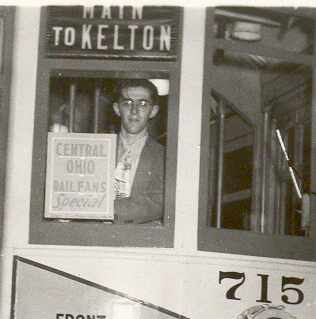Home > Streetcars > roster-intro
|
Columbus Streetcar Rosters 1891 - 1948
Click on the photos below to expand
Note: This section is a work in progress, rosters will be added as as time permits.
Recreating the equipment roster for the Columbus streetcar system has been greatly aided by work that the late B.J. Kern did in combing the records of the Columbus & Southern Ohio Electric Co. in the 1950's. (The photo to the right is of Mr. Kern in 1947.) One source of information was an inventory prepared by the Columbus Railway Power & Light Company in January 1911 of all equipment it owned as of June 18, 1903. This provided a mostly complete inventory of cars from #200-453. Many of the cars before #200 were retired by 1911 and probably 1903. These were the horse cars of which little information is available and the cars that started the electric streetcar era in 1892. Information on these cars is more limited. The Beginning Period - 1891-1895, cars #101-252 and #274-282, - will cover the single truck streetcar period and single truck trailers that were probably converted horse cars. The electric streetcars were popular right from the start and the streetcar companies had to scramble to get enough cars for the crowds they were being asked to carry. Cars were purchased from multiple builders and the Columbus Street Railway Company even resorted to building their own streetcar bodies for a while. Four wheel #235 represents streetcars from this period. It was built by the Brownell Car Co. in 1893. It seated 28 people on bench seats that ran against the windows so that there would be space for standees. The car had open platforms which were not popular with the crew and even contributed to labor unrest resulting in at least one strike. (The photo of #235 is from the DAK collection.) The Growth Period - 1895-1903, car #253-273 and #284-496, - will cover the double truck wood cars that evolved into the classic Columbus Streetcar Style. They had large platforms on each end for ease of loading and unloading and bench seats to allow room for many standees. Car #470 is shown to represent the double truck streetcars that were the main stay of the streetcar system for years. Columbus was a heavy user of the maximum traction trucks. These trucks had one axle with large powered wheels and an unpowered axle with smaller wheels. Car #470 had two 76 hp motors which represented an increase over the two 50 hp motors on four-wheel car #235. (The photo of #470 is from the DAK Collection.) The Stability Period - 1905-1918, cars #497-668 were a similar design to the Growth time cars with the addition of the Pay-As-You-Enter scheme which provided for better people flow allowing faster loading and unloading especially in the High Street congested area. These cars were mostly provided by the G.C. Kuhlman Car Co. of Cleveland, Ohio. CRP&L Co. Streetcar #590 is an example of cars from this period. Double deck car #1000 also fits into this time period. The Ending Period - 1925 - 1937, cars #700-915 saw a change to one man cars and cars with steel bodies. Cars #700-723 were the last new cars purchased by Columbus Railway Power & Light Company. After that used streetcars were available as replacements for the 500 and 600 series cars. The 700-915 cars would serve the system while the $8 million, 1933-1948 modernization program was implemented. Car #717 was one of the first of the one-man cars, eliminating the need for a conductor. It was more powerful than its predecessors which meant it had faster acceleration and a higher speed allowing it to run on a tighter schedule. (This photo is from the Columbus Metropolitan Library collection.) From the very beginning up to 1917 heavy use was made of open cars. Open cars could seat more people than closed cars and were faster loading and unloading. The Ohio State Legislature outlawed open cars in 1917 and they were gone by 1920. Some were converted to closed cars. Open cars were great for heading to one of the streetcar company amusement parks. This photo compares the single truck open car with the more up-to-date, double truck open cars. Car #231 built by the J.G. Brill Co. in 1892 seated 40 passengers each paying 5 cents for the ride. Car #411 built by the St. Louis Car Co. in 1903 seated 60 passengers still paying 5 cents for the ride. (Photo from DAK collection) |

